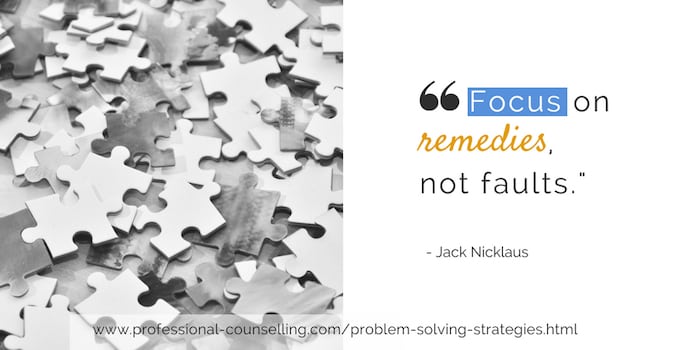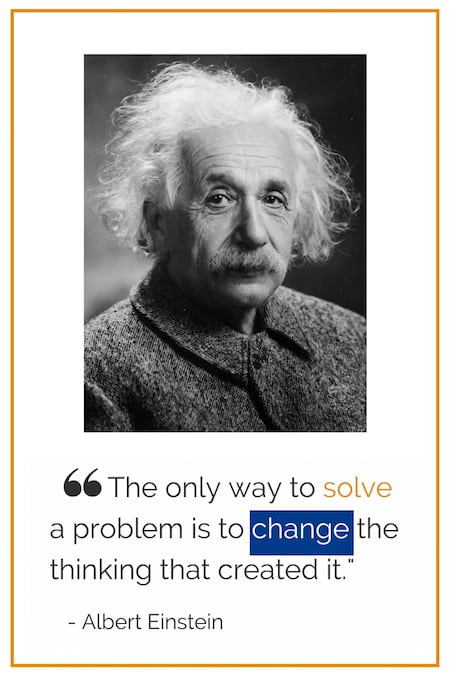Intimate Tickles Thought You Might Be Interested
Published: Wed, 04 Jul 2018 12:48:43 +0000
View Original Article
Category: Better Relationships | Author and Publisher: Elly Prior | First published: 24-09-2010 | Modified: 04-07-2018
How to identify the precise nature of a problem, in a relationship or at work, before you address it
Sometimes problems seem to come in bunches, and/or a particular problem can feel overwhelming.
But don’t despair – I’m here to walk you through my step-by-step problem solving strategies. We’ll start by asking all the right questions to help you identify precisely where you need to direct your energy in order to solve the problem(s).
 Everything can be figured out! However, sometimes you have to accept that there’s simply no *ideal* solution
Everything can be figured out! However, sometimes you have to accept that there’s simply no *ideal* solutionIdentifying the problem
Uncovering essential information as part of your problem solving strategy will prevent you from:
- solving only part of the problem and finding yourself having to deal with the same issue again in the future
- solving the wrong problem
- misusing your resources or leaving vital resources unused
- becoming absorbed by the problem and too emotional, which makes it much harder to for you to put things right
Abstract and over-generalised thinking causes minor issues to appear much bigger than they really are, and significant problems to appear unmanageable.
Being quite specific about what exactly the problem is will give you a more realistic picture. In turn, this will give you a better handle on the problem. You’re less likely to feel overwhelmed if you approach issues with my problem solving steps below.
You may also want to amplify your critical thinking with the Improve Your Critical Thinking hypnosis download (via my Hypnotherapy online FAQ page).
Self-hypnosis can also be really helpful for reducing stress. Short-term pressure is okay, but stress stops you being able to come up with creative solutions. And when you’re dealing with problems, you need to be able to be creative!
Dealing with several problems at once?
The first problem solving strategy is: start with the problem that is quickest to resolve. However, if you’ve had to resolve that problem several times already, it needs to be analysed to discover its root. Your problem solving technique so far may have been to yank at the weed, leaving the real trouble spot intact underground.
Is the issue you’re dealing with a people-problem?
If so, as part of your problem solving strategy, I’d really recommend that you familiarise yourself with the human givens (see link further down). The human givens consist of our innate resources and essential emotional needs. When you take these human givens into account, you and the people around you will really thrive, and problems will be resolved that much easier.
Dealing with a relationship problem? Not sure whether to go or stay? The problem solving tool to use for that is my comprehensive relationship test.
Case study of the application of my problem solving strategy
The case study below is a very simple example of how a problem seems to have disappeared. When you’re dealing with a people-problem, your problem solving strategy should include techniques to help calm someone right down.
If you’re feeling particularly emotional then you too will feel much more capable if you can calm yourself before you carry on trying to solve the problem(s).
I’ve practised as a school/college counsellor as well as a couple counsellor and a work-place counsellor/welfare adviser for one of the emergency services.
My client here was a young person in college, but equally could have been an adult with a relationship problem, or a troubled employee. The crux of the problem was not the situation itself, but my client’s perception of the situation…
Limited thinking – a case study
Click on the triangle to reveal the content.
Jenny was unhappy, hated college, and decided she was going to change colleges after her exams. She didn’t want to do the all-important final two years where she was currently studying. Jenny was the victim of emotional black and white thinking.
First of all, I spent some time calming her right down. Only then did I work with her to look at all the factors that created the problem. I helped her to think clearly by asking the right questions (see steps below). We explored what exactly she thought was so awful and how often she was exposed to that awfulness. I also asked her who and what she liked and valued.
What was the exact problem? She disliked two teachers, one of whom she only saw for one hour a week. She found one subject really hard, but hadn’t asked for help. She had fallen out with a friend, but had already made new friends.
What was the real problem? The real problem was her perception of the situation. Once her perception had changed, there simply was no problem anymore. The outcome? Much to her surprise, she found that in reality things were not so bad after all and she was happy to stay. The situation hadn’t changed, but her perception of it had.
 The best problem solving strategy starts with asking the right questions to find the most appropriate solution
The best problem solving strategy starts with asking the right questions to find the most appropriate solutionStep 1: gather essential information as part of your strategy
The real problem may actually be very different to the one you think you have! Take your time with my problem solving techniques – there’s no need to rush the steps.
Don’t even worry if it takes you several days to answer the questions – think of this as a project and a new start. So why not pour yourself a drink, kick off your shoes and get started…
Take a big sheet of paper, draw a circle for each of the contributing factors and write in the details to start off your problem solving steps:
The time
- When exactly does the problem occur?
- When exactly is it at its worst?
- When does it not occur?
- Can you identify a pattern from this information?
The place
- Where exactly does the problem mostly occur?
- Where does it not occur?
- Can you identify a pattern?
The sequence
- What exactly happens before the problem occurs?
- How exactly does the problem start?
- What happens that causes the problem to continue?
- What exactly was your train of thought?
- What are you doing/feeling/seeing/hearing?
- Can you identify a pattern?
Other people
Friend or foe – how are they detracting from or contributing to your problem and problem solving strategies?
- What significant people are present or absent when the problem occurs?
- What do others/your partner/friend/colleague/family think about the problem?
- Who doesn’t know about the problem and should know?
- What do you anticipate they might think when they find out?
- Can one of them play devil’s advocate to give you a completely different perspective?
- Can you identify a pattern from the information you’ve gathered?
Your role
- What part of the problem is for you to sort out and no-one else?
- What do you think are your personal weaknesses?
- What evidence of those do you have?
- What actions can you take to turn those weaknesses into strengths?
- Are you able to separate yourself from the problem by giving it a colour, name or shape?
- What part of the problem do you actually have (some) control over?
- What assumptions did you make when you previously tried to sort out this problem?
- Do you need help with the problem?
Your resources and strengths
The most important aspect of any problem solving strategy is to take stock of your personal resources for solving the problem(s).
- What parts of your role as a partner/colleague/employee/friend are working well?
- What evidence do you have for that?
- What exactly are you doing that makes it work well?
- What skills and resources do you use in your spare time and at work?
- What are your achievements? (These could be large one-offs or simple everyday ones, e.g. passing your driving test, getting your PhD or cooking a meal)
- Who has solved a similar problem? How did they do it?
- Who can help and/or advise you whilst remaining objective?
- Who can support and encourage you whilst remaining objective?
- Who do you admire? And how do you imagine they might have solved the problem?
- What would you consider to be life’s little treats? (e.g. a hot bath, first flowers in spring, looking at art, reading an inspiring book, etc.) It’s vital to be aware of the things you consider to be treats when you want to recharge your energy!
Beyond the problem
- What would you be doing/concentrating on if you didn’t have this particular problem right now?
- How exactly would you and/or the situation be different?
- What would your friends/family/colleagues notice about you/the situation?
- What would happen if you just ignored the problem?
- Could you view the present situation as an alternative solution, even though it’s clearly not ideal?
- Are there any possible benefits of the situation?
- Can you make any other changes, without having to solve the problem first?
- How would you ideally like it to end?
- What small steps can you take towards an eventual solution or part-solution?
- What can you do today that will make a difference tomorrow?
- Are there any other opportunities to turn a negative in a positive?
- What will you settle for if all else fails?
Step 2: analyse and identify the exact problem
You’ll have already gathered specific details about the problem(s), so now I’d like you to take a deep breath, have a break and make yourself another drink. Then we can proceed with the following problem solving techniques…
- Decide on your headings: either for every aspect of that one problem, or for all of the different problems. Break things up into smaller parts if necessary
- Draw a mind map or flow-chart, or draw the problem in whatever way makes sense to you
- Include your resources (i.e. your strengths and capabilities) under each heading
- Think about whose problem it really is - it might not be yours… but do be honest with yourself
- Write a short statement about how you feel about the problem and what exactly it is (this will help you to communicate more effectively with others)
Step 3: decide!
The tree which moves some to tears of you, is in the eyes of others merely a green thing that stands in the way.”
William Blake
Well done for having completed another step! The next problem solving strategy is to devise a solution – finally! I know this is ultimately what you’re looking for, however problem solving techniques are wasted if you end up dealing with the wrong problem. This could be either one that doesn’t exist, or one that you create in the process of trying to solve it.
10 Point problem solving plan
- Decide what the ideal solution for you would be
- Decide what you can live with
- Decide on an alternative solution
- Decide on the steps you can take right now to bring about some change. This will help you to feel more positive and in control
- Decide who you need to ask for help
- Decide what you think other people might need from you and check with them
- Decide who you need to have a conversation with, what you would say and when that might be possible
- Make a list with exact timings of your planned actions. This is one of the most important problem solving techniques
- Set a review date to hold yourself (and maybe others) to account
- Sleep on it, but have a notepad by the side of your bed. Just as you drift off you may come up with the most brilliant problem solving technique. If you don’t write it down there and then, you’ll probably have forgotten by the morning!
You’ve now identified exactly what the problems and potential solutions are. Perhaps you’ve even broken them up into smaller parts.
The next problem solving strategy is to deal with the smallest (or easiest) one first, to help build your confidence.
Alternatively, you can decide to go for the big one the moment you get out of bed and … get it done!
Step 4 – review your problem solving techniques and strategies
There’s no point in having a plan with problem solving techniques if you don’t review it. You need to check your progress against all your action points and their respective dates.
The following questions will help you to mark the progress you’ve made…
- What exact problem solving steps have you taken to solve the problem (or even just part of it)?
- Which problem solving techniques and strategies were successful and which were less so?
- What should you continue to do? (i.e. what works!)
- What parts of the plan could do with an update?
- Are other people keeping to their side of the bargain?
- What can you do to encourage or remind them?
- Set another review date
There is no failure, only feedback!
Applying my problem solving steps and strategies
These problem solving techniques can stop you from becoming overwhelmed when you face a problem that seems hard to figure out. You can use all the above information to make a problem-solving flow chart – at home, in your relationship or at work.
Take your time creating it and sleep on it. You can also discuss it with someone you trust to help you uncover any blind spots. This easy to use decision making tool will help too.
Once you’ve got a robust process in place, you’ll be able to work through any problem you’ve got now, and any that you might encounter in the future. All you have to remember is to stay calm, ask the right questions, and draw on your innate resources to make your solutions reality!
Please, rate this article …
I really hope this article is of help to you. 🙂
I frequently update my articles based on feedback, therefore I really value your vote.
Thank you so much in anticipation. 🙂
Related Articles
The Human Givens
Natural Depression Treatments
How to Deal with Criticism
Anger Managements Tips
Breaking Up Tips
Facebook Relationship Problems
Managing Stress in the Workplace
How to Divorce
25 Common Relationship Problems
Managing Stress in the Workplace
Tips to Relieve Stress
Other Helpful Links
The Six Types of Socratic Questions
Do you need help?
Talk to an online counsellor…
Your problem is never too small or too big, too silly or too complicated to ask for help from a licensed therapist…
I want to upfront with you – I may earn a commission from BetterHelp. You pay the same fee, regardless.
Feel free to ask for help, or comment on this article

Hello you! 🙂
It’s me – Elly Prior, I’m the Founder and Author of this site. I’m a ‘real’ person and I check the comment sections daily.
Do feel free to ask for help. I would gladly write a few lines to help you.
If my article in some way is of help to you, please let me know. I’d be so delighted!
Oh, and English is not my native language (I lived in the UK for many years). Whilst my articles are edited, my comments here are spontaneous and unedited.

